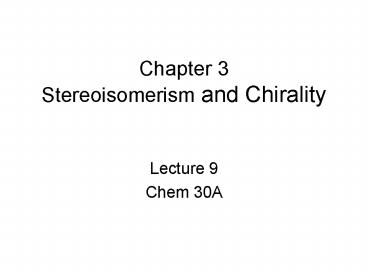Chapter 3 Stereoisomerism and Chirality - PowerPoint PPT Presentation
1 / 15
Title:
Chapter 3 Stereoisomerism and Chirality
Description:
... and Chirality. Lecture 9 ... Chirality. Chiral: From the Greek, cheir, hand ... Achiral: An object that lacks chirality; one that lacks handedness. ... – PowerPoint PPT presentation
Number of Views:192
Avg rating:3.0/5.0
Title: Chapter 3 Stereoisomerism and Chirality
1
Chapter 3Stereoisomerism and Chirality
- Lecture 9
- Chem 30A
2
Isomers
- Isomers Different compounds with the same
molecular formula. - Constitutional isomers Isomers with a different
connectivity. - Stereoisomers Isomers with the same connectivity
but a different orientation of their atoms in
space.
3
Chirality
- Chiral From the Greek, cheir, hand
- an object that is not superposable on its mirror
image - Achiral An object that lacks chirality one that
lacks handedness. - An achiral object has at least one element of
symmetry. - Plane of symmetry An imaginary plane passing
through an object dividing it so that one half is
the mirror image of the other half. - Center of symmetry A point so situated that
identical components of the object are located on
opposite sides and equidistant from that point
along any axis passing through it.
4
Elements of Symmetry
- Symmetry in objects
5
Elements of Symmetry
- Plane of symmetry
6
Stereocenter
- The most common (but not the only) cause of
chirality in organic molecules is a tetrahedral
atom, most commonly carbon, bonded to four
different groups. - A carbon with four different groups bonded to it
is called a chiral center. - All chiral centers are stereocenters, but not all
stereocenters are chiral centers. - Enantiomers Stereoisomers that are
nonsuperposable mirror images. - Refers to the relationship between pairs of
objects.
7
Stereocenters and Chiral Centers
8
Enantiomers
- 2-Butanol
- Has one stereocenter.
- Here are four representations for one enantiomer.
- Here are two representations for the enantiomer
of (4).
9
Enantiomers
- The enantiomers of lactic acid drawn two
different ways
10
Enantiomers
- 2-Chlorobutane
11
Enantiomers
- 3-Chlorocyclohexene
12
Enantiomers
- A nitrogen chiral center
13
Resolution
- Racemic mixture An equimolar mixture of two
enantiomers. - because a racemic mixture contains equal numbers
of dextrorotatory and levorotatory molecules, its
specific rotation is zero. - Resolution The separation of a racemic mixture
into its enantiomers.
14
Resolution
- One means of resolution is to convert the pair of
enantiomers into two diastereomers. - Diastereomers are different compounds and have
different physical properties. - A common reaction for chemical resolution is salt
formation. - After separation of the diastereomers, the
enantiomerically pure acids are recovered by
addition of an achiral acid.
15
Resolution
- Racemic acids can be resolved using commercially
available chiral bases such as 1-phenylethanamine.
- Racemic bases can be resolved using chiral acids
such as































